Snatch vs Clean & Jerk: Olympic Lifts Compared
Author:
Reviewed by:
(21 years of Oly Lifting experience)
Unlock your full potential by engaging with our experts and community! Have questions about your fitness journey or looking for expert advice on weightlifting techniques? Don’t hesitate — leave a comment below and Sergii Putsov will provide a personalized answer and insights to help you reach your goals.
Torokhtiy is reader-supported. Some links are affiliate links, and we may earn a commission at no extra cost to you. See our disclosure page for details.
Before understanding whether it is necessary to compare and look for similar elements in clean and snatch, let’s look at the features of these exercises. This article will help athletes and coaches improve their understanding of the biomechanics of these movements in order to improve the quality of lifting and the design of programs.
Where the bar finishes up is the main difference between both the clean and snatch. In the clean, you lift the bar from the platform to your shoulders, but in the snatch, you lift it from the ground to overhead position in one smooth motion.
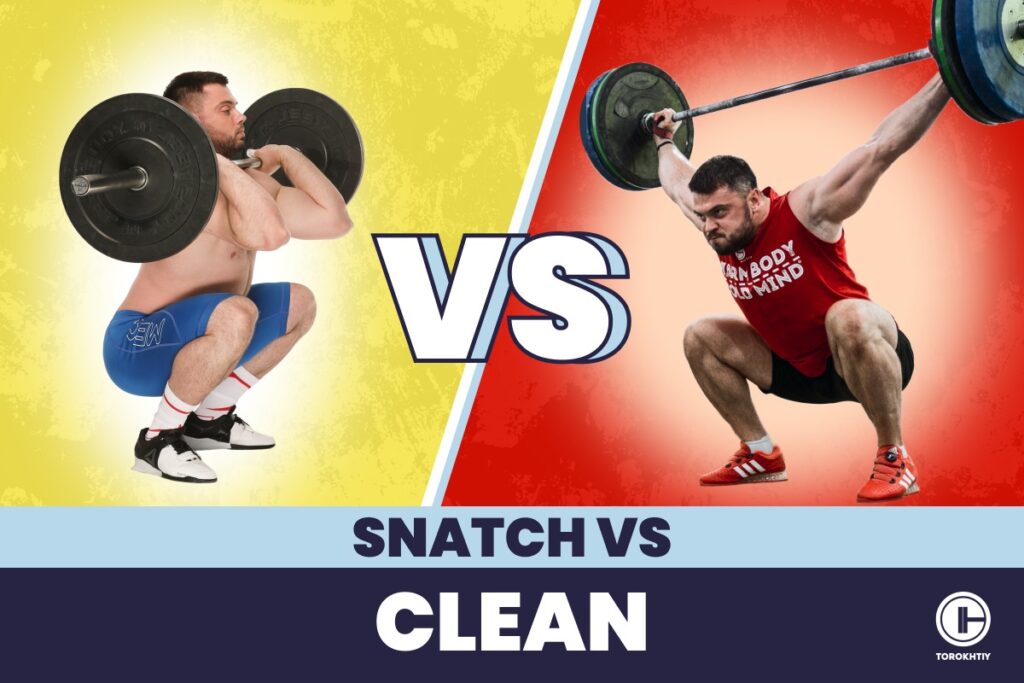
So What Is the Difference Clean vs Snatch?
Although both lifts share the same basic idea – pull the bar from the ground and receive it in a squat, the mechanics, goals and demands of the snatch and the clean are quite different. Understanding these differences snatch vs clean and jerk helps athletes and coaches choose the right accessory work and avoid mixing techniques that don’t match.
Snatch vs Clean: Key Differences
| Criteria | Snatch | Clean |
|---|---|---|
| Initial Body Position | Hips lower; torso more horizontal; shoulders clearly over the bar. | Hips higher by ~10–15 cm; torso more upright; shoulders still over the bar but less bent forward. |
| Grip Width | Wide (snatch grip) → longer bar path. | Narrower (clean grip) → shorter bar path. |
| Weight Used | Lighter loads, usually 14–30% less than clean | Heavier loads, clean allows higher weights |
| Movement Pattern | Faster pull; emphasis on maximum bar height and speed. | Slower pull; emphasis on using bar “elasticity” and strong power position. |
| Angles & Levers | More closed knee angles (~74°); deeper squat receiving position. | More open knee angles (~89°); body is more vertical during pull. |
| Transition Phase | Shorter transition (0.13 s). | Longer transition (0.15 s) because of heavier load. |
| Full Extension Timing | Extension lasts longer (0.17 s). | Extension is shorter (0.13 s). |
| Technical Demand | Highly technical; demands high mobility, precision, speed, reactivity. | More strength-driven; requires strong legs, timing, bar whip control. |
| Use of Bar Whip | Minimal – wide grip reduces ability to use bar elasticity. | High – clean relies on bar whip for turnover and receiving position. |
Simple Explanation for Amateur Lifters snatch vs clean and jerk weightlifting styles
- The snatch is all about speed, mobility and precision. You need to pull fast, create height and drop under the bar with perfect timing.
- The clean is about strength, power and using the bar’s elasticity.
The pull is slower, heavier, more forceful and the turnover requires a powerful transition.
Because the two lifts rely on different mechanics, beginners should avoid training snatch-technique drills and clean-technique drills in the same session.
Mixing them often creates technical confusion – especially in hip contact, bar path, and timing. In the context of weightlifting snatch vs clean and jerk, separating these technical sessions helps athletes develop each lift more efficiently and prevents overlapping errors.
What is Snatch?
Snatch is one of the exercises in Olympic weightlifting. During the competition, the snatch is performed first, and after it, the athletes perform the second exercise – Clean & Jerk. Snatch is a technically complex movement that requires speed, strength, agility, flexibility and mobility of the main joints
Snatch Pros & Cons
Positives:
Could be better:
How to Do Snatch?
The Olympic Snatch consists of five phases:
1. Starting Position
The athlete takes the bar in hookgrip with a wide (snatch) grip, sits down and arches his back. In this position, the projection of the athlete’s shoulders should be slightly in front of the knees. The center of gravity is in the middle of the foot, and the arms are straight and relaxed.
2. First Pull
The athlete pulls the bar from the platform as close to the legs as possible. His tasks: to maintain balance in the middle of the foot, cover the barbell with his shoulders, keep the muscles of the arms relaxed. The pull is performed until the moment when the athlete brings the barbell into the power position, the so-called “contact point”.
3. Second Pull
Pull continues above the knees… With the barbell at the contact point, the athlete sharply extends the knees and hips, basically jumping up and actively directing their elbows up.
4. Power Position
At the peak of the second pull, the athlete achieves a power position by fully extending their body and directing their elbows up.
5. Turnover
After full extension, the athlete instantly switches the direction of movement of his body down, fixing the bar above his head on straight arms in a low squat position.
6. Receive
In the receiving phase, the athlete catches the barbell above their head while in a squat position, maintaining stability and control.
7. Recovery
From the overhead squat position, the athlete stands up on straight legs with the barbell still held securely above their head.
At competitions, after fixing the barbell, the judge gives the command to the athlete to lower the barbell to the platform.
Simple Snatch Progression
The snatch is one of the most technical movements in weightlifting, so beginners should not jump straight into the full lift. Instead, learning the snatch is much easier when you break it into small pieces and master the key positions first.
When comparing clean and jerk vs snatch, this step-by-step approach is even more important because the snatch demands greater mobility, precision and overhead control from the very beginning.
Below is a simple, beginner-friendly list of accessory exercises that build the skills needed for a complete snatch.
1. Overhead Position & Stability
Before pulling from the floor, you must learn how to hold the bar overhead with confidence.
Overhead Squat – teaches stability, balance, and bottom-position confidence.
Snatch Balance – trains fast turnover and strong receiving position.
2. Turnover Mechanics
Learning how to “flip” the bar overhead is essential.
Muscle Snatch – builds upper-body coordination and bar control.
Tall Snatch – teaches vertical pull and fast elbow turnover.
Drop Snatch – improves speed under the bar.
3. Contact & Power Position
Improving the contact coordination and body extension.
Hits + High Pulls from above knee Complex – help to understand contact flow
Hip Snatch – reinforces vertical drive.
4. Pulling Fundamentals
These exercises teach bar path, leg drive, and hip extension.
Snatch Deadlift – builds strength in the start position and first pull.
Snatch Pull – develops power in the second pull and correct extension mechanics.
High Pull (Snatch Grip) – trains bar height and explosive finish.
5. Full Movement Integration
Once parts are mastered, combine them into full movement variations:
Power Snatch – full movement but easier to control.
Full Snatch – final step, combining all phases.
Common Snatch mistakes
Even though the snatch is a highly technical movement, most errors come from just a few fundamental problems. Fixing these early helps lifters build consistent, efficient technique and prevents injuries.
1. Starting Too Fast
Many beginners “yank” the bar from the floor.
Problem: Losing balance, early arm pull, bar swings away.
Fix: Slow, controlled first pull – think “push the floor away”, not “rip the bar up.”
2. Early Arm Bend
Bending the elbows before the hips finish extending is one of the most common issues.
Problem: Kills power, ruins bar path, makes turnover slow.
Fix: Keep arms long and relaxed until full extension.
3. Bar Drifting Away From the Body
The bar should stay close throughout the entire pull.
Problem: Forward bar path leads to missed catches.
Fix: Lats engaged, straight bar path, bar “shaves the shirt.”
4. Weak or Late Extension
Rushing under the bar before fully extending the body.
Problem: Not enough bar height → unstable catch.
Fix: Finish the pull – hips, knees, ankles extended.
5. Poor Turnover Speed
Slow elbows or lifting the bar up instead of moving under it.
Problem: Catch becomes unstable or too high.
Fix: Practice Tall Snatch, Drop Snatch, Snatch Balance.
6. Crashing the Bar in the Receive
The bar collapses onto the shoulders rather than being caught smoothly.
Problem: Loss of balance; hard to stand up.
Fix: Meet the bar actively with tension (reach up) and speed.
7. Incomplete Overhead Mobility
Snatch requires strong T-spine and shoulder mobility.
Problem: Rounded back, unstable overhead position.
Fix: Overhead squats, thoracic mobility, snatch grip presses behind the neck.
8. Standing Up Too Early
Trying to recover from the squat before stabilizing overhead.
Problem: Bar shifts, wobbling, missed lifts.
Fix: Pause 1–2 seconds in the bottom before standing, especially during warmup.
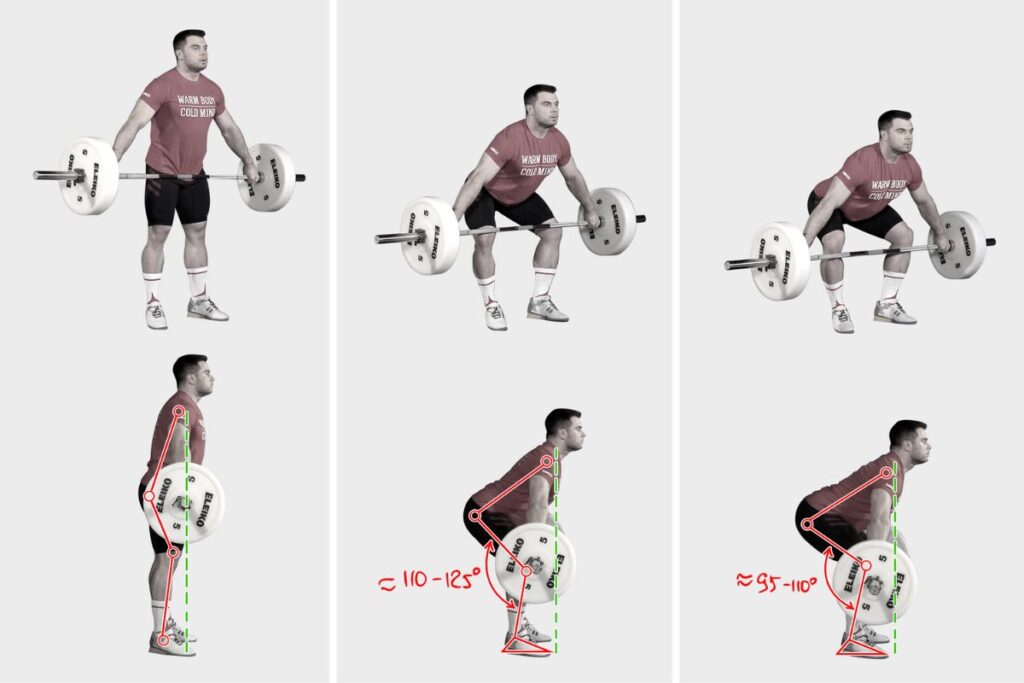
Snatch Variation and Alternatives
Snatch variations help athletes develop specific phases of the lift, address weak points and improve coordination without always performing the full movement. Here are five useful variations and alternatives for lifters of all levels.
1. Power Snatch
A snatch caught above parallel squat depth.
Why use it: In the context of power snatch vs power clean, the power snatch builds speed, confidence, and powerful hip extension while reducing mobility demands. It’s perfect for beginners and for developing a more aggressive turnover.
2. Hang Snatch (Above or Below Knee)
Snatch performed from the hang position instead of the floor.
Why use it: Teaches patience, proper bar path and a strong second pull. Helps athletes improve contact point timing.
3. Snatch High Pull
Explosive pull with focus on bar height and elbows up.
Why use it: Trains power, extension mechanics and bar trajectory without the complexity of catching overhead.
4. Snatch Balance
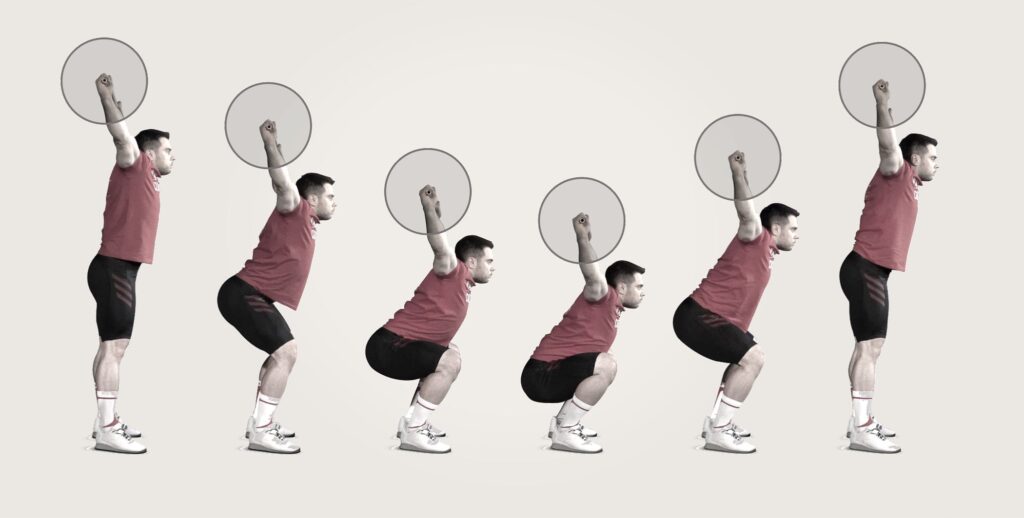
Dropping under the bar from the shoulders to a full overhead squat.
Why use it: Builds fast footwork, aggressive dive under the bar, and strong overhead receiving position.
5. Muscle Snatch
Upper-body–driven turnover without using a squat.
Why use it: Improves bar control, turnover strength, and stability. Great warm-up drill for sharpening technique.
What is Clean/Clean & Jerk?
The clean and jerk is also one of the exercises in Olympic weightlifting. During the competition, the clean and jerk is performed second.
Olympic clean and jerk is definitely a powerful and complex movement. It is clear from the name that it is divided into two sections.
The first part – clean: the athlete pulls the bar off the platform and lifts it to his shoulders, then jerk it off his shoulders in overhead position.
There are 3 jerk styles:
- Split Jerk – pushing the bar overhead into an athletic lunge
- Power Jerk – the athlete pushes the bar from his shoulders, spreads his feet to the sides approximately shoulder-width & fixes the bar above his head in a semi-squat, then straightens his knees
- Squat Jerk – the athlete copies the power jerk movement, but when fixing the bar above his head, he takes the position of a full squat, then rises to the fixation position
For the attempt to be recognized as successful by the judges, the athlete must hold the weight above his head on straight arms, straighten his legs, placing his feet parallel.
Clean Pros & Cons
Positives:
Could be better:
How To Do Clean?
Clean is a first part of Olympic exercise Clean & Jerk and it consist of 5 phases:
1. Starting Initial Position
The goal of the starting position is the effective angles for the pull and acceleration. The athlete places his feet shoulder-width apart, the feet are turned slightly to the sides, the balance is in the middle of the foot, the lower back is arched, the hands are in a hookgrip slightly wider than the shoulders
2. First Pull
The athlete lifts the bar slowly, keeping it close to the legs, balance in mid-foot. Shoulders are over the bar and arms are relaxed until the bar passes the knees.
3. Second Pull
Once the bar passes the knees, the athlete should explosively extend their hips, knees, and ankles to drive the bar up. This should almost look like a jump because it’s so powerful.
4. Turnover & Catch
Right after full extension of the body, when the barbell is at the level of mid torso, the athlete changes his direction of movement down, rotates his elbows as quickly as possible and catches the bar in a low squat.

5. Recovery
After fixing the barbell on the shoulders in a deep squat position, the athlete must stand up. The fast transition from eccentric to concentric muscle mode is an essential technical component of the recovery period.
This is the muscular contraction that occurs as you descend to full squat and quickly stand back up. After lifting from a squat, the lifter has a couple of seconds to prepare for the jerk.
Follow us!

Free!
Get a 2-week Weightlifting Program as a bonus for the subscription to kickstart your training plan!

Free!
Simple Clean Progression
The clean combines strength, power, timing and mobility. For beginners, the easiest way to learn it is to break the movement into smaller pieces and master each phase separately. This progression helps lifters build confidence in the pull, turnover and receiving position before attempting the full lift.
When looking at clean and jerk weightlifting vs snatch, this structured approach is essential, because the clean demands more strength and front-rack control, while the snatch requires greater speed and mobility from the start.
1. Front Rack & Squat Basics
Before learning the pull, athletes must feel comfortable holding and standing up with the bar.
Front Rack Position – teaches proper wrist, shoulder and upper-back position.
Front Squat – builds leg strength and front-rack stability.
2. Turnover & Catch Mechanics
Learning how to rotate the elbows quickly and catch the bar high.
Elbows Rotation – gives basic understanding of upper body mechanics,
Tall Clean – trains fast turnover without leg drive.
Muscle Clean – teaches bar path and smooth rack delivery.
3. Pulling Fundamentals
These drills teach balance, bar proximity, and explosive extension.
Clean Deadlift – reinforces starting angles and bar control.
Clean Pull – builds power for the second pull.
Clean High Pull – helps generate bar height with correct hips and elbows.
4. Hang Clean Progressioт
Removing the floor phase makes learning easier and teaches positioning.
Hang Clean Above Knee – reinforces patience and strong second pull.
Hang Clean Below Knee – connects pull phases without overloading technique.
5. Full Movement Integration
After mastering the pieces, combine them into the full clean.
Power Clean – simplified full movement with easier catch.
Full Clean – complete exercise with full squat receiving position.
Common Clean mistakes
The clean is powerful, technical, and fast – which means beginners often repeat the same errors. Fixing these early builds safer, more consistent technique and improves the ability to lift heavier weights over time.
1. Pulling With the Back Instead of the Legs
Athletes often “lift with the back” by raising the hips too early.
Problem: Bar drifts forward, weak extension, loss of balance.
Fix: Push the floor away, keep chest up, knees and hips rising together.
2. Early Arm Bend
Just like in the snatch, bending the arms too soon kills power.
Problem: Short bar path, slow turnover, poor rack position.
Fix: Keep arms long and relaxed until the hip extension is complete.
3. Bar Too Far From the Body
Letting the bar swing or drift away reduces efficiency.
Problem: Crashing catch, lost bar path, missed lifts.
Fix: Keep lats tight; bar stays closer.
4. Weak Contact at the Power Position
Some athletes miss the hip contact or create it incorrectly.
Problem: No acceleration, weak second pull, no bar speed.
Fix: Practice hang cleans and clean pulls to develop consistent contact.
5. Slow or Incomplete Turnover
The clean requires aggressive elbows.
Problem: Bar crashes onto shoulders, unstable receiving position.
Fix: Tall Clean, Muscle Clean and fast-elbow drills.
6. Catching the Bar on the Wrists Instead of the Shoulders
Poor mobility or slow turnover often leads to a painful rack position.
Problem: Wrist stress, collapsing chest, instability.
Fix: Improve front-rack mobility and practice quick elbow rotation.
7. Overpulling or “Jumping Forward”
Jumping forward means the bar path is off.
Problem: Loss of efficiency, unstable catch.
Fix: Focus on vertical extension and staying balanced in mid-foot.
Clean Variation and Alternatives
Clean variations help athletes refine specific phases of the lift, develop power and improve technique without always performing the full clean. These movements target weaknesses such as turnover speed, pulling power, front-rack stability and timing.
1. Power Clean
A clean caught above parallel squat depth.
Why use it: In the comparison of power snatch vs power clean, the power clean lets you handle heavier loads, develop stronger leg and hip drive, and refine front-rack timing. It sharpens bar path and simplifies the receiving phase, making it ideal for beginners learning how to clean efficiently.
2. Hang Clean Below Knee
Clean performed from the hang position instead of the floor.
Why use it: Teaches patience in the pull, correct hip contact and a strong second pull. Excellent for reinforcing proper sequencing.
3. Clean Pull
A powerful extension of the clean without turnover or catch.
Why use it: Develops maximum leg and hip drive, improves bar speed and strengthens the power position.
4. Muscle Clean
Clean performed entirely with upper-body turnover, no squat.
Why use it: Builds smooth bar path, fast elbows and front-rack strength. Great warm-up and technique drill.
5. Clean High Pull
Explosive pull with focus on bar height and elbow direction.
Why use it: Trains aggressive triple extension and helps lifters feel the correct “elevation” needed for heavy cleans.
The Difference Between Snatch and Clean
The story when they say about an athlete that he is a master of a snatch, but it didn’t work out with a C&J, is quite common. On the contrary, it also happens: when in a snatch of three attempts the athlete barely twists into one, and then in the clean and jerk you need to jump over all rivals in order to “catch” on the medal.
That is why the question of the differences between snatch vs clean and jerk is very important.
One of the reasons for these problems is that coaches and athletes do not see the difference in technique between the two exercises. Therefore, training and learning are carried out according to the same requirements, which ultimately leads to the fact that the technical skill of one of their exercises suffers.
While some argue that you should focus on deadlifts before attempting cleans, many people successfully do power cleans or clean pulls without including deadlifts into their routine. It’s possible to master the power clean directly and still achieve excellent results.
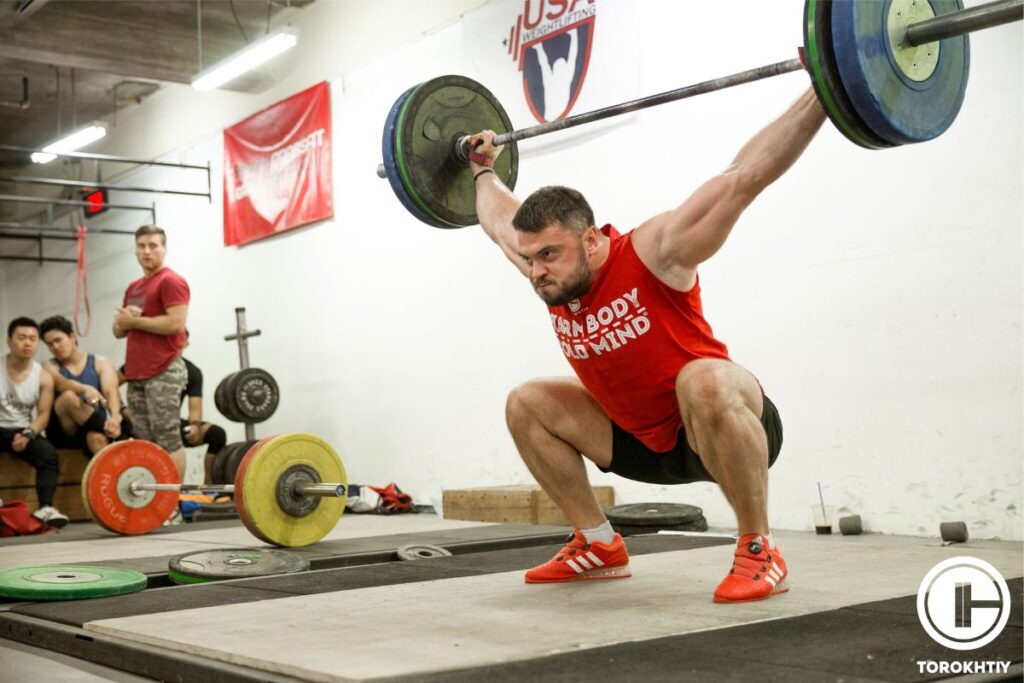
So what is the difference between snatch and clean?
Let’s start with the fact that a fairly large number of technical parameters of these exercises differ not only visually, but statistically. Back in 1978, Soviet sports scientists (V. Frolov, A. Lukashev) conducted research and came to a number of conclusions.
Basically, the differences are associated with a significantly higher weight (14-30% on average) and a narrower grip in the clean. In the starting position, the upper body is 10-15 cm higher than in the snatch.
The angles in the knee joints in cleanest (average 89°) are greater than in the snatch (74°) by 15° (20%). It should be noted that in clean all phases of the movement, the angles in the knee joints are more open.
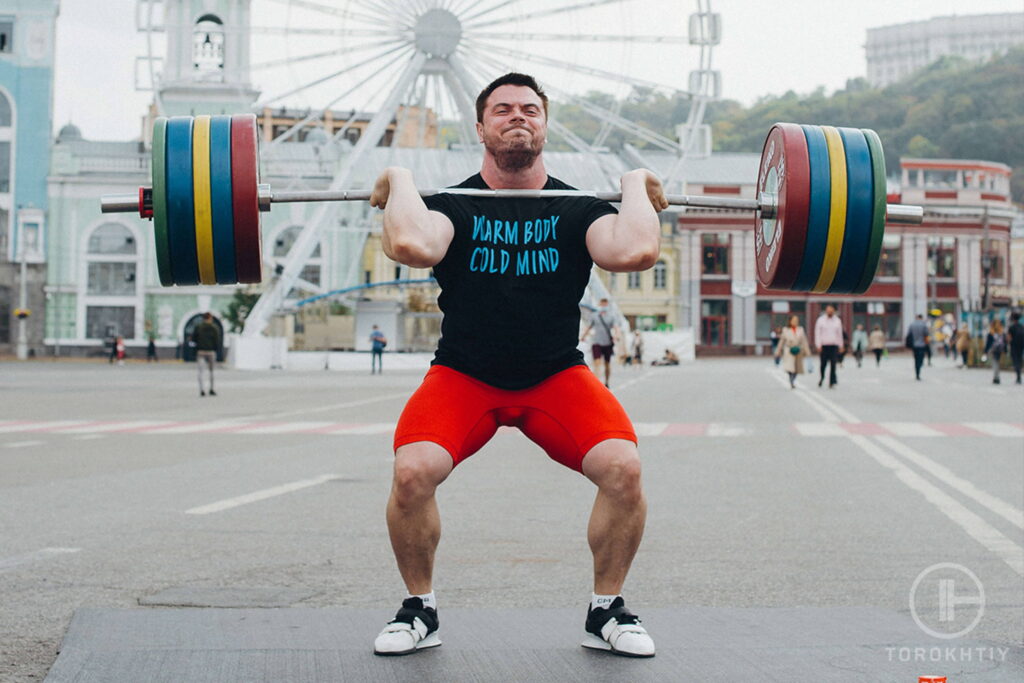
In clean the pull lasts longer (0.52 s) than in the snatch (0.45 s), primarily due to the difference in the weight of the bar.
If we compare the time indicators of the transition and the full extension phase in two exercises, then in the snatch the transition is shorter (0.13 s) than the full extension (0.17 s), and vice versa in the clean – the transition is longer (0.15 s) than the full extension (0.13 s).
First of all, the transition in the clean is longer than in the snatch, because the weight of the bar is much greater, and the speed of movement is less. The full extension is faster, since in the clean, the body is more vertical, that is, its angle of inclination is less
Another important technical snatch vs clean: when performing a snatch with a wide grip, it is almost impossible to use the elastic properties of the bar, and the path of application of efforts is much longer than in clean.
Therefore, the decisive factor in the success of the snatch is the technical component, namely the maximum speed and the maximum height.
That is why, success in the snatch directly depends on: the speed of contraction of the athlete’s muscles, the reactivity of the nervous system and the vector of application of efforts, that is, on the level of technical skill.
In the clean, the result very much depends on the ability to use the elastic properties of the barbell. The head coach of the USSR national team Alexei
Medvedev investigated this issue back in 1986. In the clean, a double accentuated application of efforts is necessary – in pull and in power position. A more powerful pull is needed in order to use the elastic properties of the barbell and achieve maximum speed in this short section.
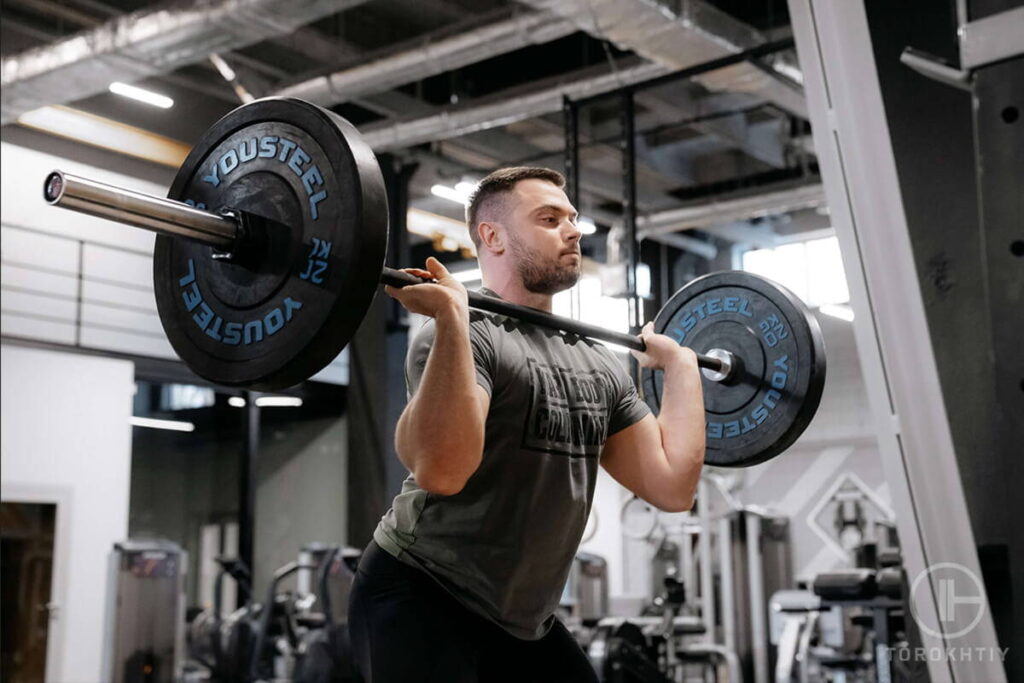
Also, the acceleration power allows you to “free yourself” for a short time to switch the work of the muscles of the legs, torso and arms from the extension mode to the turnover and create rigidity for receiving the barbell in the squat. In order for this element to be possible, active efforts must be applied already in the pull.
It is important to remind athletes that a too powerful or explosive start of movement in snatch and clean, in which the force on the support will exceed 150%, can lead to the loss of rigid interaction between the links of the body in the pulling or power position phase, which will inevitably lead to a series of errors in subsequent phases of the movement.
If we compare the forces applied to the support, then in the clean they are less than in the snatch (by 5-8%) in the pull and power position. This is due to the weight and the length of the path of the applied efforts.
Thus, this comparative analysis clean vs snatch indicates the biomechanical differences. Therefore, it is not recommended for beginners athletes to combine exercises aimed at improving the technique of both exercises in one session.
Performing in one session is only acceptable during the competitive period, when the goal of the training is to prepare the athlete for the stressful conditions of the competition.
So, what does all of this mean for you? Basically, it means that the clean relies more on strength and the elastic properties of the barbell, while the snatch depends on speed and technical precision. Beginners should train these lifts separately to avoid technical errors and improve performance.
FAQ
Is a Snatch Harder Than a Clean?
The most common answer is that snatch is more technically difficult and clean requires way more strength. In general, you ought to be able to clean more than snatch. This is due to the fact that you can or at least should be able to front squat way more than you can overhead squat.
What’s the Difference Between a Clean and Jerk and a Snatch?
The Clean & Jerk lets you employ all of your unbridled strength, whereas the snatch is all about form, coordination, and mobility. Both movements increase muscular mass, speed, and strength.
Conclusion
Thus, this analysis points to the biomechanical differences between the snatch and the clean. Understanding this will allow coaches and athletes to more consciously select assistance exercises for training programs. And now it’s your turn! Are you team snatch or clean? What are your fitness goals with either one? Let me know in the comments!
Also read:
- Power Snatch
- Snatch Pull
- CLEAN & JERK
- Clean Pull
- Hang Muscle Snatch Exercise
- Hang Clean Pull
- Hang Snatch High Pull
References:
- Helland C, Hole E, Iversen E, Olsson MC, Seynnes O, Solberg PA, Paulsen G. Training Strategies to Improve Muscle Power: Is Olympic-style Weightlifting Relevant? Med Sci Sports Exerc. 2017 Apr;49(4):736-745. doi: 10.1249/MSS.0000000000001145. PMID: 27820725.
- Comfort P, Haff GG, Suchomel TJ, Soriano MA, Pierce KC, Hornsby WG, Haff EE, Sommerfield LM, Chavda S, Morris SJ, Fry AC, Stone MH. National Strength and Conditioning Association Position Statement on Weightlifting for Sports Performance. J Strength Cond Res. 2023 Jun 1;37(6):1163-1190. doi: 10.1519/JSC.0000000000004476. Epub 2023 Mar 22. PMID: 36952649.
- Huebner M, Meltzer DE, Bjarnason Á, Perperoglou A. Comparison of Olympic-Style Weightlifting Performances of Elite Athletes: Scaling Models Account for Body Mass. Med Sci Sports Exerc. 2023 Dec 1;55(12):2281-2289. doi: 10.1249/MSS.0000000000003252. Epub 2023 Jul 7. PMID: 37436931; PMCID: PMC10662604.
- Ang CL, Kong PW. Field-Based Biomechanical Assessment of the Snatch in Olympic Weightlifting Using Wearable In-Shoe Sensors and Videos-A Preliminary Report. Sensors (Basel). 2023 Jan 19;23(3):1171. doi: 10.3390/s23031171. PMID: 36772210; PMCID: PMC9919757.
- Liu G, Zhu H, Ma J, Pan H, Pan X, Zhang Y, Hu T, Fekete G, Guo H, Liang M. A Biomechanical Study on Failed Snatch Based on the Human and Bar Combination Barycenter. Appl Bionics Biomech. 2022 May 10;2022:9279638. doi: 10.1155/2022/9279638. PMID: 35592871; PMCID: PMC9113912.
- Photos are made by Torokhtiy Media team.
Why Trust Us?
With over 20 years in Olympic weightlifting, strength training, nutrition coaching, and general fitness our team does its best to provide the audience with ultimate support and meet the needs and requirements of advanced athletes and professional lifters, as well as people who strive to open new opportunities and develop their physical capabilities with us.
By trusting the recommendations of our certified experts in coaching, nutrition, and sports training programming, as well as scientific consultants, and physiotherapists, we provide you with thorough, well-considered, and scientifically proven content. All the information given in the articles concerning workout programming, separate exercises, and athletic performance, in general, is based on verified data.
The product testing process is described in more detail here.
Author: Sergii Putsov
Head of Sport Science, PhD
Best Results: Snatch – 165 kg,
C&J – 200 kg
Sergii Putsov, Ph.D., is a former professional weightlifter and National team member, achieving multiple medals in the 94 kg weight category at national competitions. With a Master’s degree in “Olympic & Professional Sport Training” and a Sport Science Ph.D. from the International Olympic Academy, Greece, Sergii now leads as the Head of Sport Science. He specializes in designing training programs, writing insightful blog articles, providing live commentary at international weightlifting events, and conducting educational seminars worldwide alongside Olympic weightlifting expert Oleksiy Torokhtiy.
Reviewed by: Oleksiy Torokhtiy
Olympic Weightlifting Champion, PhD in Sport Science
Best Results: Snatch – 200 kg,
C&J – 240 kg
Oleksiy Torokhtiy is a professional athlete boasting 20 years of experience in Olympic weightlifting. With multiple European and World titles under his belt, he has showcased his prowess in two Olympic Games (Beijing 2008 and London 2012). Upon concluding his illustrious career, Oleksiy dedicated himself to coaching. By 2022, he had conducted over 200 weightlifting seminars worldwide. He is the visionary behind an international sportswear and accessories brand known for its motto, “Warm Body Cold Mind.” Additionally, he is an esteemed author and the creator of a series of training programs and eBooks.




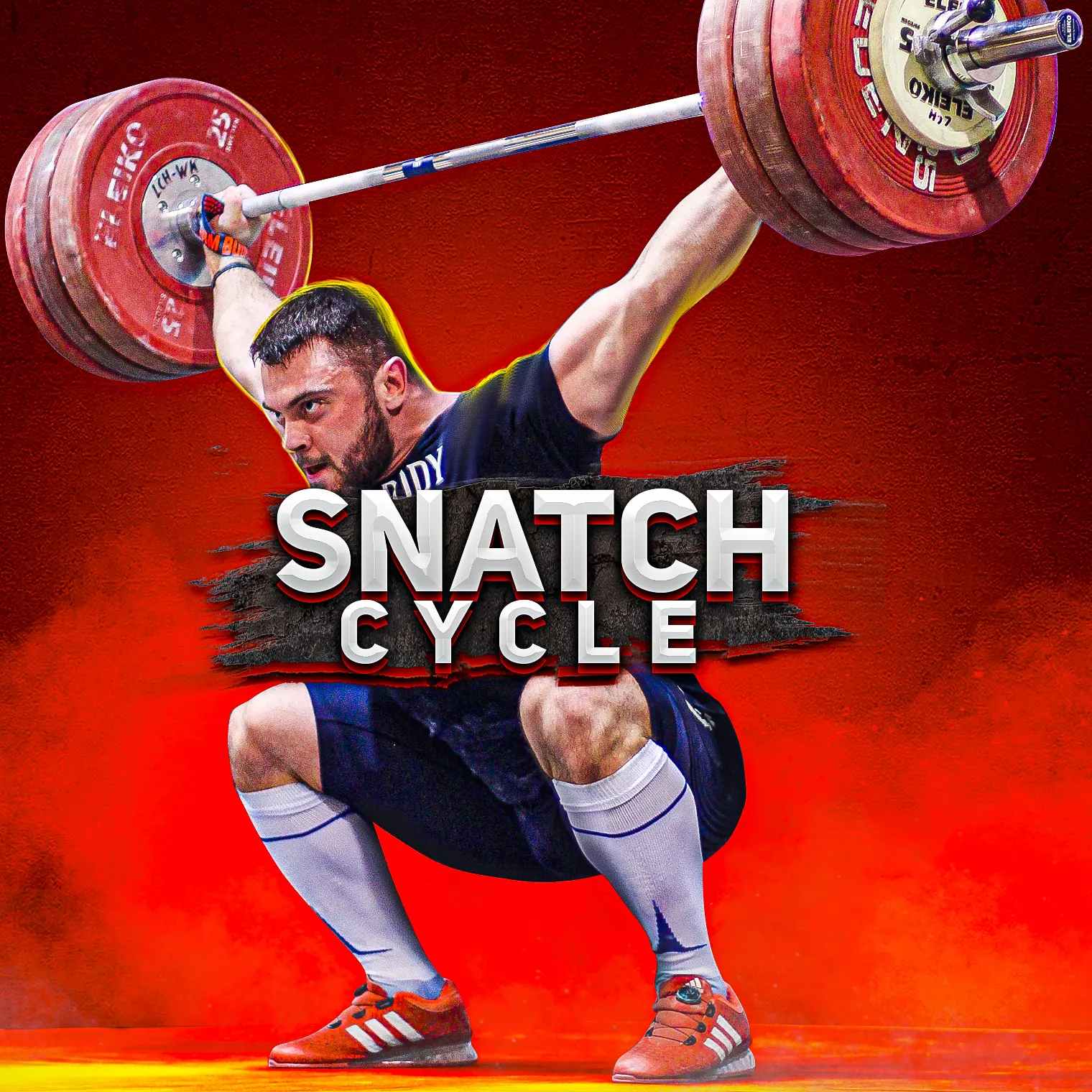
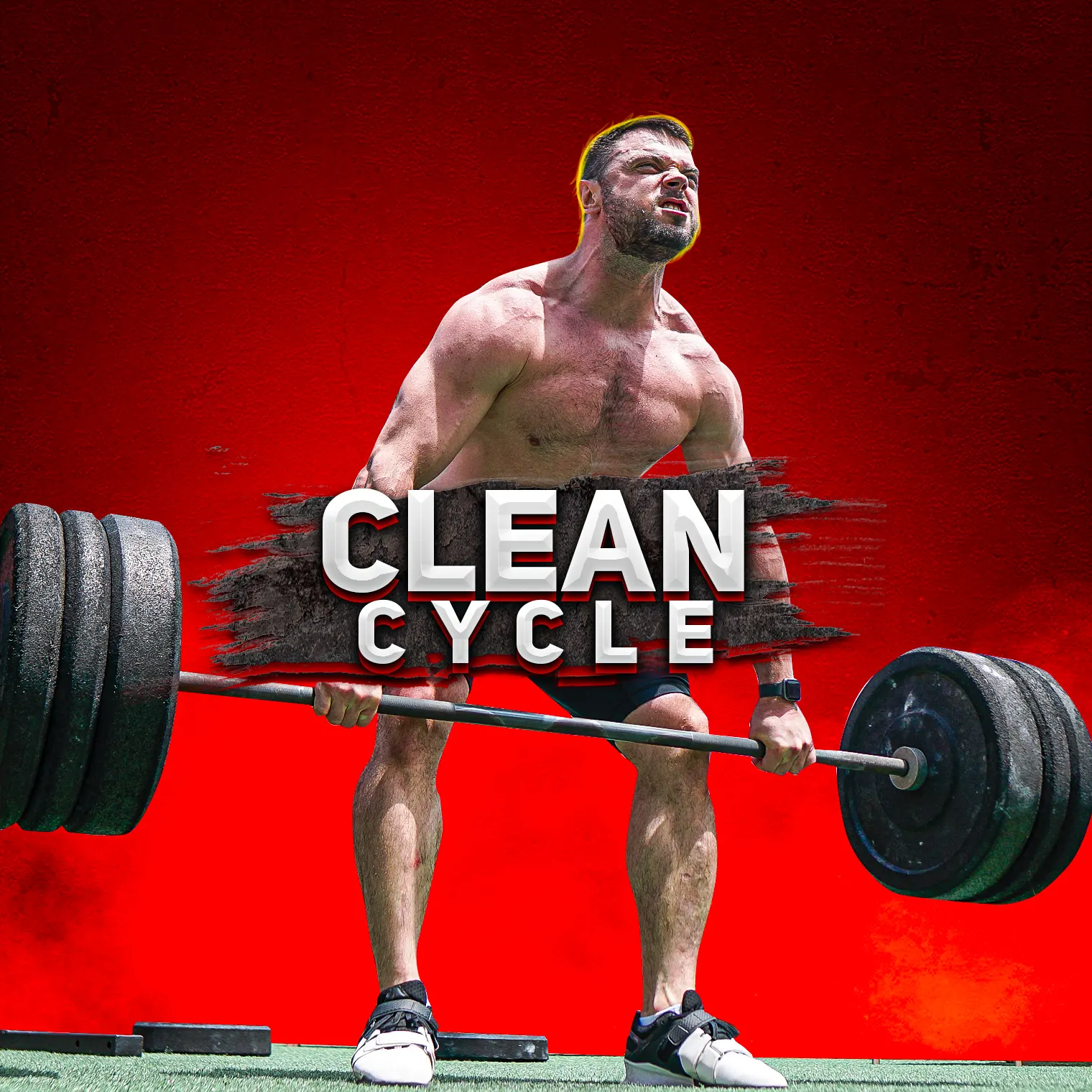
Still have questions after reading our article? Unlock your full potential by engaging with our experts and community! Don’t hesitate — leave a comment below and Sergii Putsov will provide a personalized answer and insights to help you reach your goals.